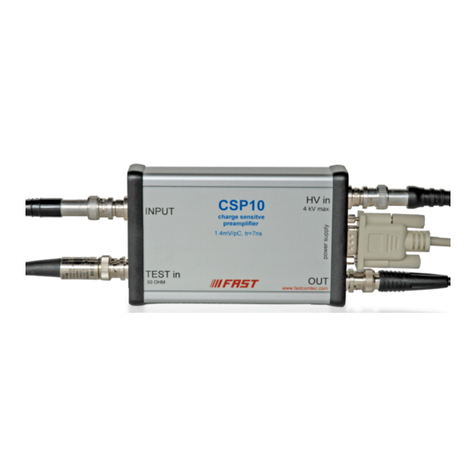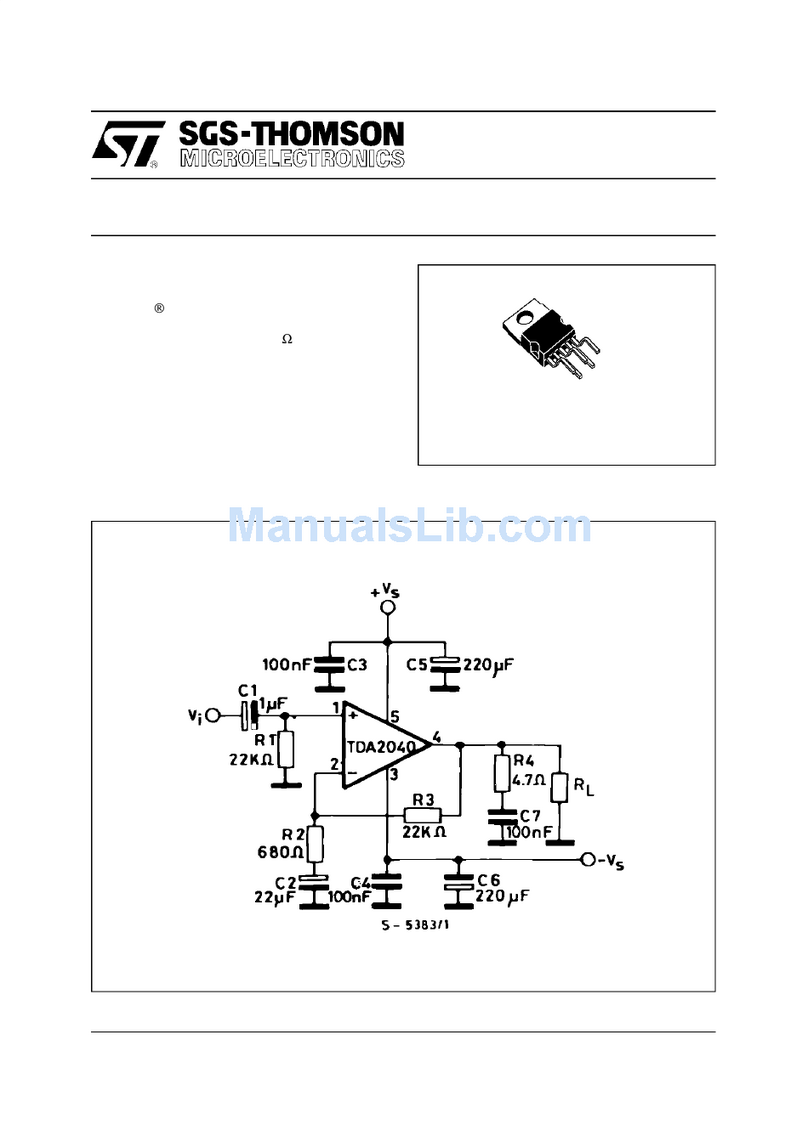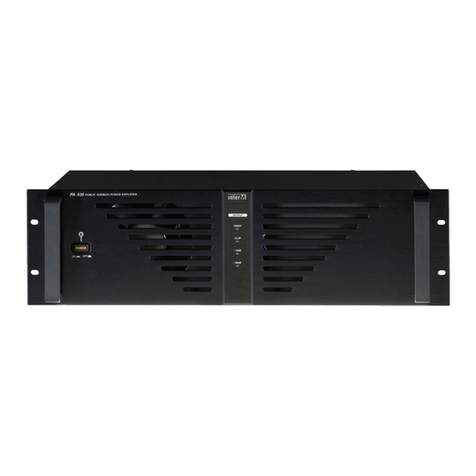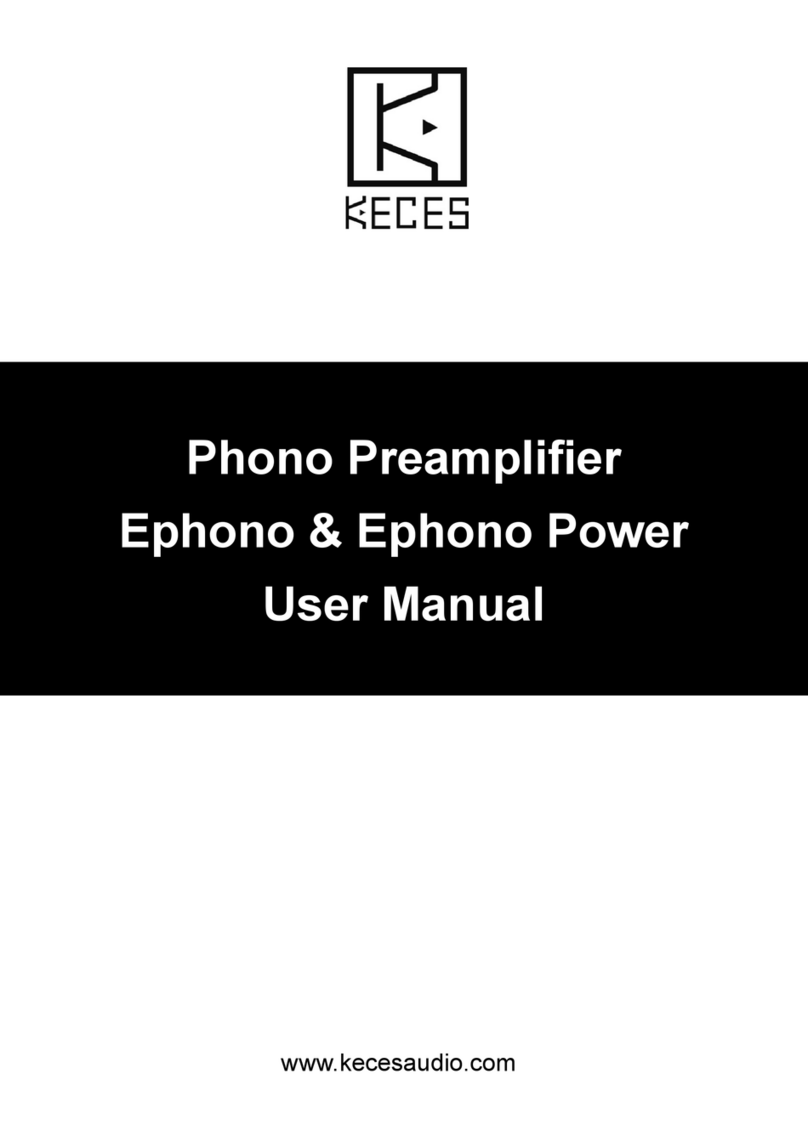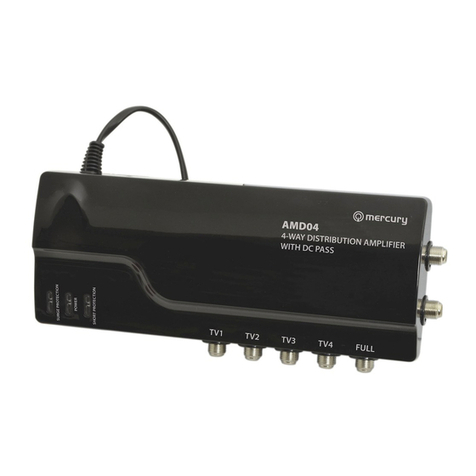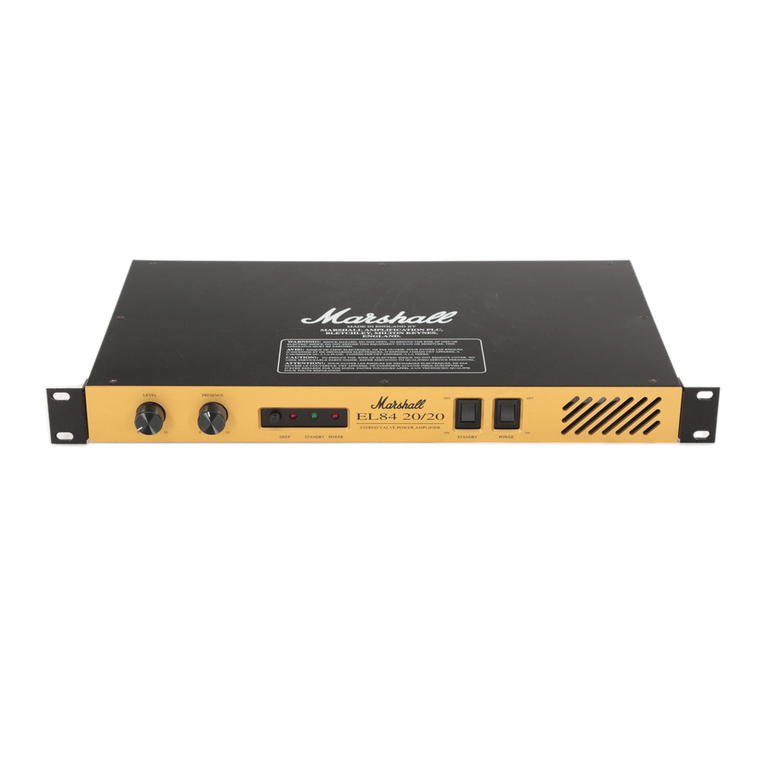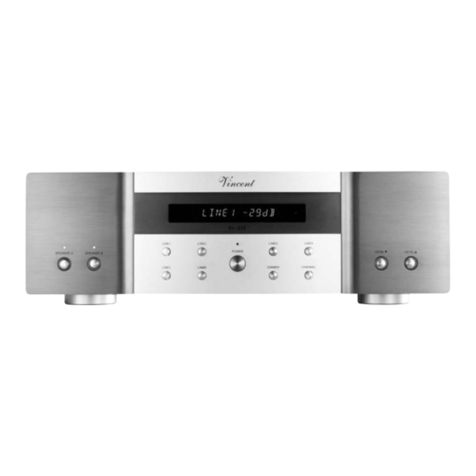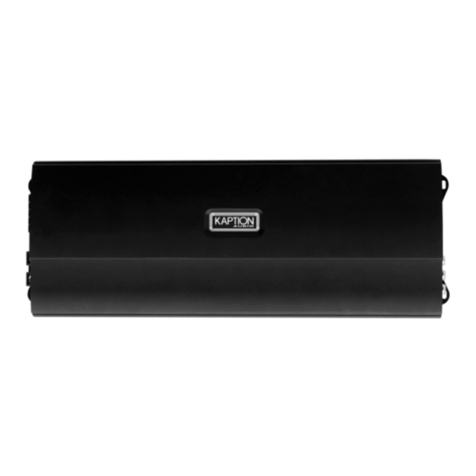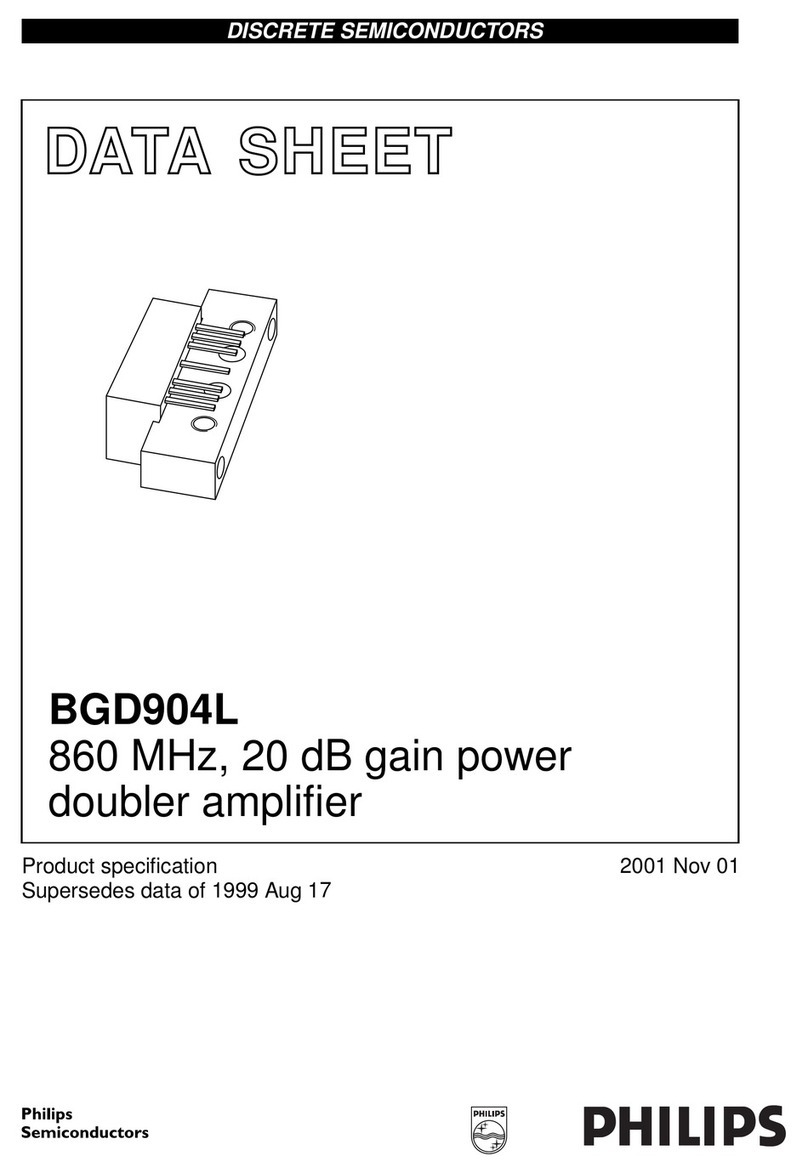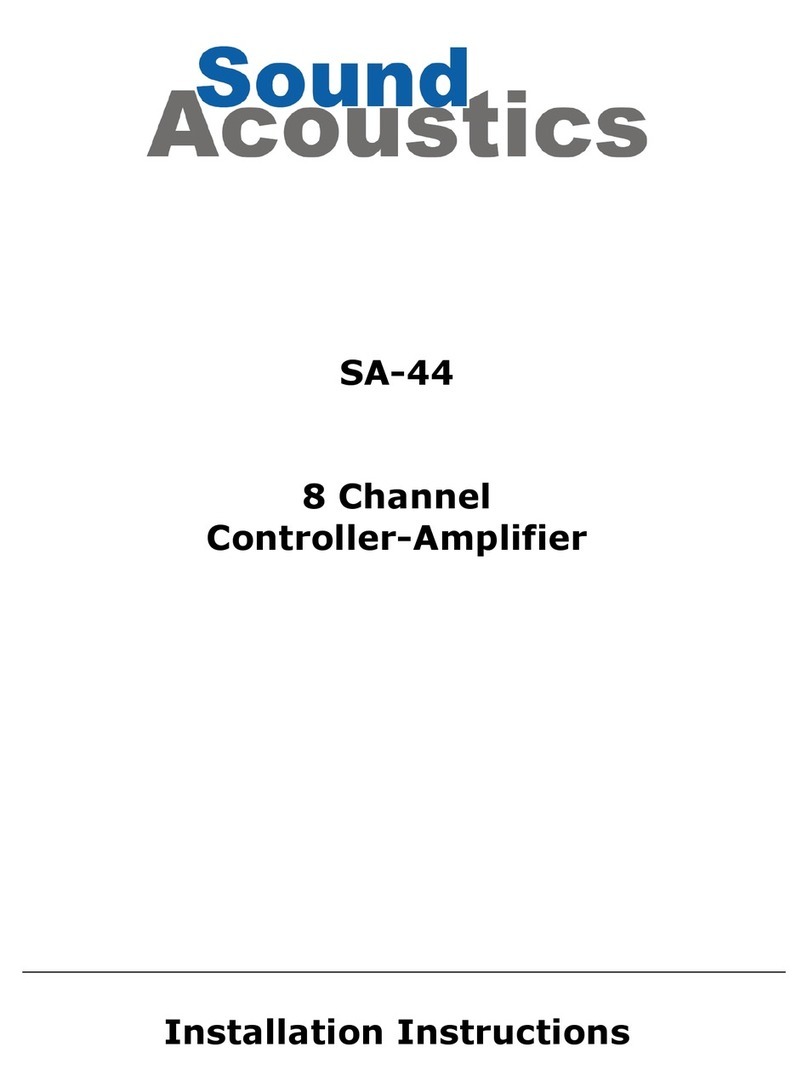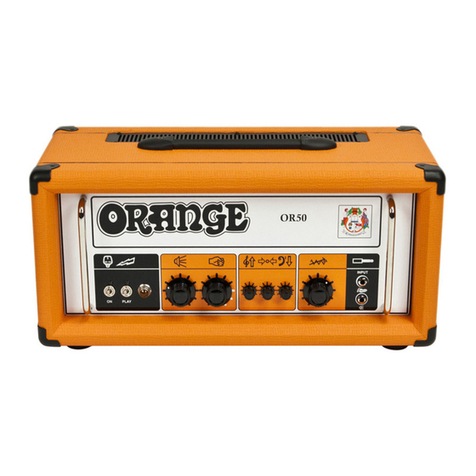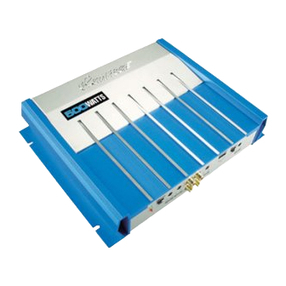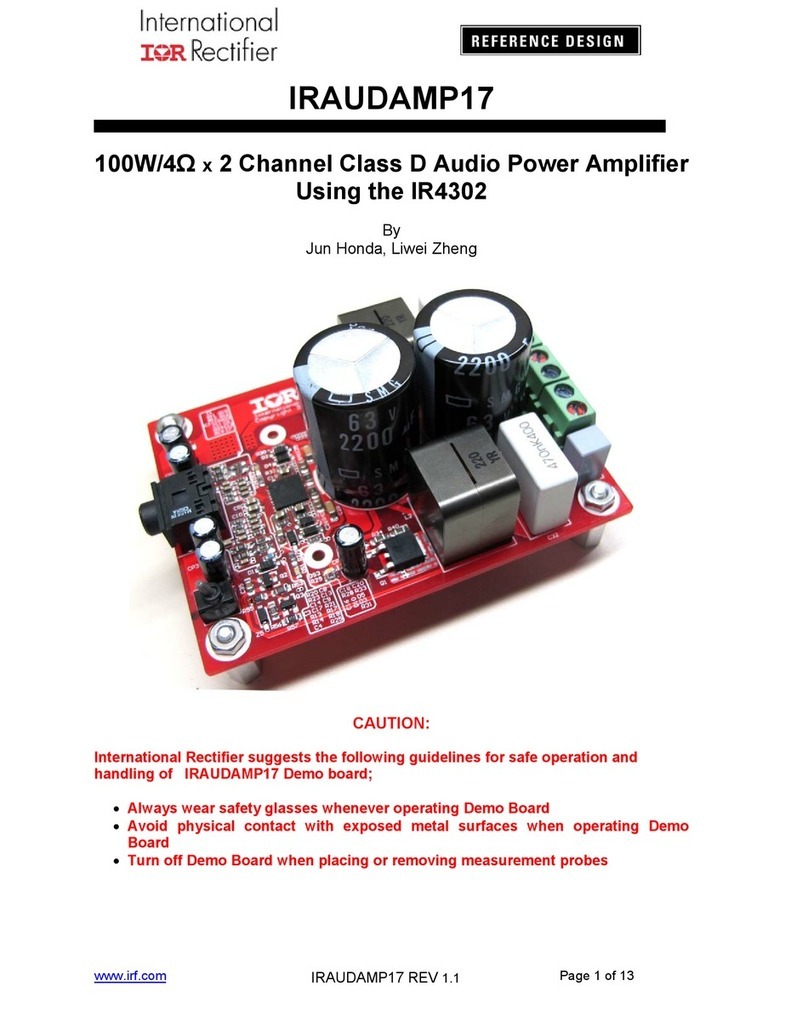Fast CR-110 User guide

*
†
Assume temp =20 oC, Vs= 9V, unloaded output
CR-110 units
Preamplification channels 1
Equivalent noise charge (ENC)*
ENC RMS 180 electrons
Equivalent noise in silicon 1.6 keV (FWHM)
2.1 keV (FWHM)
ENC slope 3elect. RMS /pF
Gain 1.4 volts /pC
Rise time †7ns
Decay time constant 140 s
Unsaturated output swing volts
Maximum charge detectable per event 2.6 x107electrons
4.2 pC
Output impedance 50 ohms
Power supply voltage (Vs)
maximum volts
volts
Power supply current mA
Vs= 13
Vs= 6
-6 to +6
minimum
Equivalent noise in CdZnTe
CR-110 charge sensitive preamplifier: application guide
General Description
Cremat's CR-110 is a single channel, low noise charge sensitive
preamplifier intended for use with various types of radiation detectors
including semiconductor detectors, photomultiplier tubes (PMTs),
photodiodes, avalanche photodiodes (APDs), and various gas-based
detectors. The CR-110 is small (less than one square inch in area),
allowing for compact multichannel detection systems to be created
using a modular design. The CR-110 can provide equal performance
with pulses of either polarity.
Detector coupling
The CR-110 can be used either in a
direct coupled
(DC) mode, or an
AC coupled
mode. These configurations are discussed below. If the
detector current exceeds 10 nA, it is recommended that an AC
coupled mode be used to prevent the resulting DC offset of the
preamplifier output from saturating.
Direct coupled operation
The above figure illustrates a typical configuration in which the CR-110
preamplifier is used to readout a detector in a 'DC coupled'
configuration. Detector current flows directly into the preamplifier input,
which is held at approximately a couple tenths of a volt below ground
potential. Detector current also produces an offset in the preamplifier
output voltage at a rate of 0.2 V per nA. A DC coupled configuration is
recommended unless high detector current causes the DC level at the
output to saturate.
Bypassed (AC coupled) operation
In cases in which detector current exceeds approximately 10 nA, an
AC coupled configuration is recommended to prevent the DC level of
the output from saturating. The above figure shows the connections
typically made in such a situation.
Package Specifications
The CR-110 circuit is contacted via an 8-pin SIP connection (0.100"
spacing). Leads are 0.020 inches wide. Pin 1 is marked with a white
dot for identification.
Measured with input unconnected, using Gaussian shaping amplifier with time constant =1
s. With a detector attached to the input, noise from the detector capacitance, leakage
current, and dielectric losses will add to this figure.
Pulse rise time (defined as the time to attain 90% of maximum value) has a linear
relationship with input capacitance. Value cited in the table assumes zero added input
capacitance. To calculate pulse rise time for practical situations, use the equation: tr=0.4 Cd
+ 7 ns, where tris the pulse rise time in ns, and Cdis the added capacitance (e.g. detector
capacitance) in pF.
Equivalent circuit diagram
The figure below shows an simplified equivalent circuit diagram of the CR-110, which is a
two stage amplifier. The first stage is high gain, and the second stage is low gain with an
emphasis on supplying sufficient output current to drive a terminated coaxial cable.. Pin
numbers corresponding with the CR-110 preamplifier are shown. Rf(100 M ) and Cf
(1.4 pF) are the feedback resistor and capacitor respectively.
Output offset -0.5 to -0.1
0.03 femtoCoul.
volts
0.85"
0.88" 0.14"
CR-110
12345678Figure 3.
input
GND
NC
GND
Vs
+Vs
NC
output
Cremat, Inc.
Operating temperature -40 to +85 oC
Figure 1.
output
filtered bias
Det bias
input
10M
0.01uF
detector
-Vpower
+Vpower
CR-110
12345678
Figure 2.
output
input
Det bias CR-110
200M
10M
0.01uF
0.01uF
12345678
detector
+Vpower
-Vpower
Amplification polarity inverting
Maximum output current (under load) mA70
18
6
2, 4
Cf
Rf
5
++
G= -20k G=+2
Figure 4.
3, 7NC
(GND)
11
Power dissipation see Figure 7

Minimization of Electronic Noise
The magnitude of the equivalent noise charge (ENC) of charge sensitive
preamplifiers is affected by a number of different factors. Although these
factors produce a certain unavoidable level of noise, additional and
preventable noise may also be introduced into the detection system by
some aspects of the circuit design. The purpose of this section is to
help the engineer design detector circuits
having the minimum electronic noise
possible, given the constraints of the
detector.
One of the more avoidable noise sources
which may be present is inductive 'pick-up'
from nearby circuitry. This can generally
be eliminated by adequately shielding the
detection circuitry and by avoiding 'ground
loops' in the layout of the circuitry. The
power supply may also contain 'ripple' that
will not be completely rejected by the
amplification circuitry. For this reason, it is advisable to RC filter both the
positive and negative power supply lines at a point close to the preamplifiers.
In addition to ensuring a quiet power supply, it is also important to RC filter
the detector bias supply at a point near the detector and preamplifier. The
types of noise described in this paragraph can be identified by their periodic
behavior. With careful circuit design, these noise sources can be eliminated
as significant factors affecting the performance of the circuitry.
One final note on providing clean power supply voltages
: Surprisingly,
some power supply regulation ICs (such as the LM317 and LM337) produce
outputs that are very noisy. This noise can couple to the preamplifier
output, producing unsatisfactory results. If these regulator chips are used to
provide supply voltages for the CR-110, it is recommended that an RC filter
combination of 4.7 /1000 F be used to filter both the positive and negative
power supplies. Alternatively, a quieter regulator circuit (such as that used
in the CR-150-X evaluation boards) could be used. See
http://www.cremat.com/CR-150.pdf for more information on this regulator
circuit.
In typical detection systems using charge sensitive preamplifiers, the ENC
(equivalent noise charge) is due to a combination of 5 factors:
1). The
series thermal noise
of the input JFET in the preamplifier (which is
proportional to the total capacitance to ground at the input node),
2). The
parallel thermal noise
of the feedback resistor and any 'biasing'
resistor attached to the detector,
3). The
shot noise
of the detector leakage current,
4). The
series 1/f noise
, which is produced by the electrical contacts of the
detector and preamplifier input JFET,
5). The
parallel f noise
caused by the proximity of lossy dielectric material
near the preamplifier input node.
These noise sources can often be individually quantified in an operating
detection system by measuring the dependence of the ENC on the "shaping
time" of the pulse amplifier which usually follows the preamplification stage.
This method is described in more detail in the article:
Bertuccio G; Pullia A; "A Method for the Determination of the Noise
Parameters in Preamplifying Systems for Semiconductor Radiation
Detectors", Rev. Sci. Instrum., 64, p.3294, (1993).
Other articles which describe typical noise sources and signal processing
techniques when using charge sensitive preamplifiers are:
Radeka V; "Low-Noise Techniques in Detectors", Ann. Rev. Nucl. Part.
Sci., 38, p.217, (1988).
Goulding FS; Landis DA; "Signal Processing for Semiconductor
Detectors", IEEE Trans. Nuc. Sci., NS-29, p.1125, (1982).
In the interest of avoiding unnecessary noise, there are a few factors
requiring attention. If AC coupling is used, an important decision to make is
the value of the "bias resistor" (resistor placed between the detector and
the filtered detector bias supply). Because this resistor is effectively "in
parallel" with the preamplifier input, it is a source of
parallel thermal noise
.
The magnitude of this noise is proportional to the reciprocal of the square
root of the resistor value. To choose a good value for this resistor, one
should have approximate knowledge of the detector leakage current. It
should be noted that the thermal noise of the bias resistor has the same
power spectrum as the
shot noise
produced by the detector leakage current.
To keep the bias resistor from being a significant source of noise, one
should choose a bias resistance that keeps the thermal noise of the bias
resistor significantly less than the detector shot noise. The point at which
the thermal noise of the resistor equals this shot noise is when the bias
resistor voltage drop is =2kT/q, or approximately 50 mV. If the voltage drop
is significantly greater than this, then you can be certain that the thermal
noise of the resistor is not limiting the performance of the circuit. To be
safe, you can use a bias resistor that will drop approximately half a volt.
Because the CR-110 uses a 100 M feedback resistor (which produces its
own thermal noise) there is no need to increase the value of the bias
resistor higher than approximately 200 M . Another consideration in the
choice of bias resistor is that a very large voltage drop across it (in excess
of several volts) may significantly subtract from the voltage drop across the
detector.
Another source of electronic noise is the thermal noise of resistances
effectively "in series" between the detector and the preamplifier input. The
thermal noise voltage that the effective series resistance produces is
converted to a "noise charge" (remember that the preamplifier output is
proportional to the charge flowing into the input) which is proportional to the
capacitance to ground at the preamplifier input. Of course it is
recommended that the circuitry minimize the series resistance between the
preamplifier input and the detector, and usually this resistance can be
reduced to a figure of less than a few ohms. Unfortunately, effective
resistance in the input stage of the preamplifier add to this figure, making it
the dominant source of the "series thermal noise". As mentioned, this
noise component is proportional to the capacitance at the preamplifier input,
and for this reason it is important to seek to minimize the input capacitance
as much as possible. Using even short sections of coaxial cable to connect
a detector to the preamplifier, for example, can significantly degrade
the noise performance. Assuming a shaping time of 1 s, this noise
component adds 3 electrons RMS of noise charge for each pF of
capacitance added to the input.
Another noise concern in the design of your detection system is the
introduction of
parallel f noise
, which is introduced by the proximity of lossy
dielectric materials at the preamplifier input. To minimize this source
of noise, which in some situations can be quite significant in magnitude,
detector circuit designs should keep the input traces on the circuit board as
short as possible. This is because the circuit board itself is often the lossy
dielectric material introducing this form of noise. Epoxy and glass, which
are usually considered to be good dielectrics (and circuit board materials) in
most circuit applications, are actually too lossy to be used in the usual
manner when designing detector circuits. Better construction materials are
Teflon and to a lesser extent alumina. These materials, however, are more
unusual and expensive than standard FR-4. To avoid the expense of Teflon
boards, consider lifting the input lines off the circuit board in some fashion,
perhaps by suspending the input lines above the board using Teflon
standoffs. If electronic noise is not a primary consideration, however, it
may suffice to use short traces on an epoxy-based circuit board. The use of
coaxial cable to couple the detector to the preamplifier may introduce noise,
not only by adding capacitance (as mentioned previously), but also because
of the lossiness of the cable's dielectric layer. If coaxial cable absolutely
must be used between the detector and preamplifier, its length should be
as short as possible.
Estimating the Electronic Noise in a Detection System
It is often useful to know what the expected electronic noise will be in a
detection system while the system is still in the design phase.
The following equation can be used to estimate the noise level in a detection
system based on the CR-110 charge sensitive preamplifier. Estimates have
been made for factors (d) and (e) mentioned previously, assuming short
traces on an FR-4 circuit board (such as those found on Cremat's CR-150-
AC-C evaluation board). This equation may be useful in allowing the user to
calculate the optimal shaping time ( in s) minimizing the electronic noise
(ENC in electrons rms) for a given detector capacitance (Cin in pF) and
detector leakage current (Idin pA).
Frequently Asked Questions
What are charge sensitive preamplifiers?
Charge sensitive preamplifiers were developed to detect the total amount of
charge flowing from a detector as the result of a 'pulse' event, such as the
detection of individual particles or gamma-rays. The preamplifiers integrate
the pulse of current flowing from the detector over time (by virtue of a small
Figure 5. Ground loops, caused
by multiple paths to ground, can
make a detection system
sensitive to external RF.
det.

capacitance in the feedback loop) to produce an output which is proportional
to the charge into the preamplifier input. A large valued resistor in parallel
to the feedback capacitor slowly discharges the capacitor, restoring the
preamplifier output to its original state. Unlike voltage sensitive preamplifiers,
charge sensitive preamplifiers must have low input impedance so that the
preamplifier can easily sink (or supply) charge from the detector.
How are charge sensitive preamplifiers more suitable for use with
particle detectors than voltage sensitive preamplifiers?
Ionizing events within detectors generally produce an amount of ionized
charge that is proportional to the energy of the incoming particle or gamma-
ray. For this reason, the detector preamplifier should be configured in a
way to produce an output that is precisely proportional to this ionized
charge. Voltage sensitive preamplifiers were first used to read out solid
state detectors when they were first developed in the '40s. A problem was
noted, however, in that the signal voltage at the preamplifier input was not
only proportional to the ionized charge, but also inversely proportional to
the input capacitance. Because the detector capacitance is usually a weak
function of the temperature, temperature drifts were causing drifts in the
preamplifier gain and degrading the energy resolution. For this reason the
charge sensitive preamplifier was developed, which has a gain equal to the
reciprocal of the feedback capacitance, and more importantly independent
of the input capacitance. For many decades, charge sensitive preamplifiers
have been the standard design for use in detectors where the energy
measurement of individual ionizing events is of interest.
The decay time of the preamplifier output pulse is quite long. Do I
have to worry that pulses will build on previous pulses and cause a
'pile up' of events?
The point at which to be concerned about the effects of pulse 'pile up' is
after the preamplifier output pulse has been filtered through a shaping
amplifier. The shaping amplifier (also called 'linear amplifier', 'spectroscopy
amplifier', or 'pulse amplifier') dramatically changes the shapes of the pulses,
generally giving them a longer risetime and a much quicker fall time, and
restores the baseline to prevent pile up as much as possible. Events that
appear to pile up before the shaping amplifier often become very clearly
separated after the shaping amplifier.
What is the bandwidth of the CR-110?
The term 'bandwidth' is generally not used when discussing charge sensitive
preamplifiers - instead one describes their rise time due to a delta current
pulse input (which charges the feedback capacitance), and their decay time
due to the discharge of the feedback capacitance through the feedback
resistance. In general, one seeks a fast pulse rise time, but not necessarily
a short decay time. In fact, if the feedback resistor value were substantially
decreased in order to quicken the decay time, the added thermal noise due
to this decreased resistance would be unacceptable.
How can we check to see whether the preamplifiers are operating
within the specified noise level?
The method described here requires the following:
1. A test circuit board (such as the CR-150-X) with an appropriate power
supply.
2. A low noise Gaussian shaping amplifier, having a shaping time of 1 s.
The CR-200-1s Shaping Amplifier used with the CR-160 evaluation board
would be suitable.
3. A pulse height analyzer.
4. A tail pulse generator or square wave generator.
5. A silicon p-i-n photodiode (Hamamatsu S1223 or equivalent), and a bias
supply (100 volts if using the Hamamatsu S1223).
6. A small 241Am isotopic source.
To measure the noise of the preamplifier, the gain of the detection system
must first be precisely measured (in keV per channel). To do this, construct
the circuit shown in Figure 2 (the CR-150-AC-X test board could be used
for this). A p-i-n photodiode should be used as the 'detector', and a bias
power supply should reverse bias the detector to its maximum allowed
value. The 241Am source should be oriented so that its emissions can
irradiate the photodiode. The circuitry and photodiode should be in a well
shielded, light tight box. Route the preamplifier output to the Gaussian
shaping amplifier (1 s), which should have its output routed to a pulse
height analyzer. Acquire a 241Am pulse height spectrum, in which you
should be able to clearly detect the 60 keV gamma-ray emission (see
Figure 6). Note the channel number at which the 60 keV photopeak is
observed. The gain of the detection system is the ratio: peak channel
number / 60 keV.
Next, disconnect the input lead of the preamplifier (pin 1) from the test
circuit board. This can be done a using a variety of methods, but make sure
that pin 1 is left floating and does not touch the circuit board or other
components. Connect the tail pulse generator (or square wave generator)
to the preamplifier via a small valued capacitor of no more than just a
couple pF. Alternatively, you can use a 'dangling wire' connected to the tail
pulse generator and rely on the small capacitive coupling between the input
and the wire to make this connection (be sure, though, that the wire does
not move during the subsequent measurements). Acquire a pulse height
spectrum of the tail pulse signal, which should appear as a Gaussian
distrubution. Measure the width of this distrubution by measuring, in
channels, the full width at half the maximum value (denoted as FWHM).
The noise can then be calculated by dividing by the previously measured
gain, to yield a figure having units keV FWHM (Si). To convert this figure to
the more generally applicable units of electrons RMS, divide by 0.0036 keV
(the ionization efficiency of silicon) and divide again by 2.355 (converting
FWHM measurements to RMS).
Figure 7 above shows the
power dissipation of the
CR-110 charge sensitive
preamplifier as a function
of power supply voltage.
This assumes the output
is unloaded and the input
unconnected.
0100200300400
0
200
400
600
800
1000
1200
Figure 6
241Am spectrum
60 keV emission
# counts
channel #
0
100
200
300
400
6 7 8 9 10 11 12 13
supply voltage
power dissipation (mW)
Figure 7
Table 4: Ordering Information
Model No. Description Order No.
CRXXX Charge sensitive preamp, SHV, 2kV/10nF, 1.4V/pC HY100
CR 110 Charge sensitive preamp, SHV, 2kV/10nF, 150mV/pC HY110
CR 111 Charge sensitive preamp, SHV, 2kV/10nF, 15mV/pC HY111
CR 112 Charge sensitive preamp, SHV, 2kV/10nF, 1.5mV/pC HY112
CR 113 Charge sensitive preamp, SHV, 4kV/4.7nF, 1.4V/pC HY113
Table 1: Sensitivity Versions
preamp
model
gain (mV / pico-
Coulomb)
max. detect.
pulse (e-)
Equiv. noise in sili-
con keV (FWHM)
CR 110 1400 1071.7 keV
CR 111 150 1086.0 keV
CR 112 15 10965 keV
CR 113 1.5 1010 230 keV
preamp
model
noise (ENC) in
e-RMS*
noise (ENC)
slope e-/pF
rise time
(Cd =0pF)
rise time
slope
CR 110 200 e-4 e-/pF 7ns 0.4ns/pF
CR 111 630 e-3.7 e-/pF 3ns 0.25ns/pF
CR 112 6,800 e-28 e-/pF 6ns 0.25ns/pF
CR 113 24,000 e-27 e-/pF 20ns 0.25ns/pF
Table of contents
Other Fast Amplifier manuals
